Creepy Beef and Webm Fill Your Soft Belly With Beef
"Blood is the goriest, bloodiest, most horrific 3D first-person action game ever made. Visit a dark world populated by hundreds of bloodthirsty enemies. You'll engage in a nightmarish battle against the minions of an ancient, forgotten god bent on wiping humanity from the face of the earth. With cultists, gargoyles, zombies, hellhounds, and an unholy host of other terrors, Blood immerses you in a world of horror unlike any you've experienced before."--Monolith website
Blood (sometimes informally called Blood: Spill Some or Blood 3D) is a PC computer game released for MS-DOS on May 31, 1997. It was developed by Monolith Productions and published by GT Interactive and distributed in Europe by Eidos. The game became well-known for its copious amounts of violence and numerous stylistic and cultural references to literary and cinematic horror works. It was also the first Build engine game to feature voxels and simulated room-over-room, which were both also seen in Shadow Warrior a few months later. The game falls in the first-person shooter category and has an arsenal of curious weapons, numerous enemies, and liberal amounts of gore.
Details [edit]
"Blood is already revealing itself to be rich and multi-dimensional, and as every day brings it a little closer to fruition, we recognize new possibilities and add new details to create the most immersive, terrifying 3D game we can. Perhaps it's the horror aspect that we find so compelling--the challenge of uniting artwork, monster behavior (AI), weapons, sound, level design, and special effects into an experience that will both frighten and entertain players of all skill levels."--Blood Website
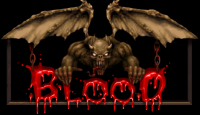
Like most games of its time, the developers garnered attention for the game by releasing the first episode as shareware. The full retail version featured all four original episodes as well as expanded weapons, multiplayer mode, and bonus features like the music video for the Type O Negative song "Love You to Death". The extreme violence in the game prompted the release of a version which removed all adult content (most notably, and ironically, bleeding).
Two different expansions, Cryptic Passage and the Plasma Pak, were released shortly after the game was produced, although only the Plasma Pak added new weapon modes and enemies. On July 15, 1998 a special edition collection titled One Unit: Whole Blood was released, which included the fully-patched full version of Blood, the Cryptic Passage expansion pack, the Plasma Pak expansion pack, and the Game Wizards interactive walkthrough/strategy guide. In total two strategy guides were released: Blood: The Official Strategy Guide by Mel Odom and Ted Chapman, and Blood: Unlock the Secrets by Game Wizards. Blood II: The Chosen, the sequel to Blood, was released in 1998 and was followed by its own The Nightmare Levels expansion pack in August 1999.
Blood and its expansions were made available for purchase from the digital distribution service GOG.com under the One Unit: Whole Blood name on April 10, 2010. This was followed by a release on Valve Software's Steam service on July 14, 2014 alongside Blood II: The Chosen and its The Nightmare Levels expansion. Atari also began selling the games directly through its own website at around the same time.
After the source code to many other games had been released by their respective owners, an intense fan campaign called for the release of the source code to Blood. This failed, but due to the cult-like fan support and lack of support from the right holders of Blood, it has been the subject of many fan games, media, and recreations. The fan project Transfusion attempted to recreate Blood on the DarkPlaces engine, while BloodCM does similar atop of EDuke32 and is at present the most complete; the former is multiplayer only, the latter single-player only. Other games like ZBlood and The Flesh Game expand on the game's storyline and scope, while HYPERTENSION is attempting to create something of a spiritual successor. A large collection of Blood fan art and fan fiction has also been produced by the community. Several attempts have been made at creating a source port via reverse engineering, with the most complete being BloodGDX, NBlood and the fork Raze.
An official remaster entitled Blood: Fresh Supply using the Kex Engine was released on May 9, 2019 by Night Dive Studios under permission from Atari. The original DOS version, with DOSBox wrappers, is now included as an extra on the GOG.com release.
Technical Specifications [edit]
See also: Installation
| Minimum CPU Required: | Pentium |
| Minimum OS Required: | DOS 4.0 to 6.22 (or compatible) |
| Minimum RAM Required: | 16 MB |
| Minimum CD-ROM Drive Speed Required: | 2X |
| Video Modes Supported: | VGA & SVGA (VESA 1.2 & 2.0) |
| Sound Devices Supported: | Adlib, General MIDI, Gravis Ultrasound / ACE, Pro Audio Spectrum / Plus, Sound Blaster, Sound Blaster AWE32 (Note: although the Pro Audio 16 is listed in the setup program it is not actually supported. A later patch was planned to add support for the card but never shipped.) |
| Input Devices Supported: | Joystick (Analog), Keyboard, Mouse |
| Multiplayer Options: | IPX, Modem, Null-modem cable |
| Number of Players (Offline): | 1 (2 on serial connection) |
| Number of Players (Online): | 8 |
Gameplay [edit]
Single-Player [edit]
"In order to prevail, the player must face the Cabal, an ancient secret society, and the terrible Dark God it serves--Tchernobog. Numerous challenges and puzzles will await players along the way, of course, and we are working on various special features that will add even greater dimension to gameplay."--Blood Website
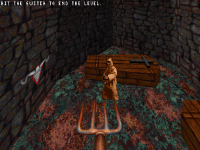
As a first-person shooter, Blood is played through the perspective of the player-controlled character. Like Doom and Duke Nukem 3D, the player must navigate through the maze-like levels of each episode (set of levels), seeking keys or activating switches to enable progress, looking for the goal that ends the level. The player does this for several levels until the "boss" level is reached and the player must defeat a large opponent to end the episode. While the player travels through the level, he/she must avoid or destroy the different enemies that attempt to kill the player.
Blood is organized in four episodes, with each episode containing a total of 8-9 different maps which consist of 6-7 regular levels, one "boss" level, and one secret level. Level design is varied, as some locations seem to lead into each other, but others jump out at the player. Some locations draw inspiration from cities in the era, with such locations as civil buildings, museums, pubs, and shopping centres. Others are generic temples or mines.
Many levels are centered around a particular location, like a mortuary, a train station, a carnival, a sewer, a hospital or a lumber mill, and each is designed to include elements typical of these places (e.g. a crematorium in the mortuary, attractions at the carnival). These often have a Victorian or Edwardian architectural style, especially seen in the "haunted house" levels. Other areas are meant to resemble maze-like temples or generic catacombs, and some are completely original, such as "E4M7: In The Flesh", which resembles the inside of a body, with walls which bleed when shot.
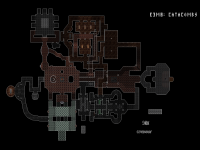
Blood was noted for its challenging, but realistic level design, as well as the abundance of enemies and weapons. Modern 3-D, fully-textured models require more computing power load, so the sprite-based game play of Blood allowed large numbers of enemies and objects on the screen at once. Also, due to the limited artificial intelligence on display, hostiles had to appear in large numbers to pose a significant challenge to the player.
The player's progress is further complicated by different types of traps, including crushing blocks, explosive barrels, lava pits, precarious cliff-sides, jumping puzzles, and combination lock doors. Blood was also one of the first first person shooter games (along with Marathon, Strife, System Shock and Dark Forces) to feature alternate firing modes for each weapon. Most guns in Blood have two completely different methods of dealing damage, compared to earlier games in which each weapon had only a single type of firing mode.
The teleporter, a common trope in first person shooter games like Quake, is rarely used in Blood, which has a less high-tech motif and adds to the realism and super natural feel. Blood also contained secrets - areas that are difficult to access or find and often contain bonuses, but added the new concept of "Super Secrets" - areas that are nearly impossible to find or reach, but which merit large rewards, such as allowing the player access to a Napalm Launcher in the very first level.
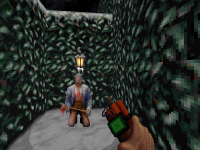
Graphic violence is one of the central features of Blood. Enemies can be blown to pieces, with streams of blood and chunks of flesh raining down. Zombie heads can be shot off and then kicked around like soccer balls, spewing fountains of blood from the neck. If enemies are set on fire, they burst into flames and run around flailing their limbs. Innocents (non-combatants) appear in several levels and can be killed without compunction. Each of these instances comes accompanied with screams of terror and pain, making sound an integral part of the violent atmosphere. The levels are designed in the same spirit, with locations such as torture chambers, funeral homes, scientific laboratories, and hellish temples. Each location features walls splattered with blood, dismembered corpses, bodies in metal drums, and other grotesque situations.
In addition, Blood contains a large number of cultural references, particularly to horror movies and slasher films. Many elements are deliberately anachronistic, including weapons, pop culture, and other details. In particular, "E2M4: The Overlooked Hotel", "E4M4: Crystal Lake", and "E4M9: Mall of the Dead" are whole levels based on the movies The Shining, Friday the 13th, and Dawn of the Dead respectively. For a complete list, see "References in Blood".
Multiplayer [edit]
See also: BloodBath Guide
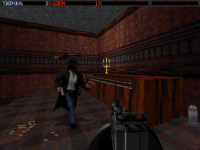
Blood is principally a single player game, but features the ability to battle other players across a computer connection. The two game modes are cooperative, which allows two players to play through a single player game, and Deathmatch (known in the game as BloodBath). The goal of this mode is to kill the other players before the player himself is killed. Gameplay takes place on an specially designed level with power-up & weapon caches and strategic areas, or a single-player level. To end the level or match, a time limit or 'frag limit' had to be reached.
One of the unique features of BloodBath was "The Voice", an audio commentator who announced an irreverent or trite phrase on each frag, humiliating the player. This added to the bloody style and competitive nature of the game, and punctuates the death of other opponents. "The Voice" is credited to Jason Hall, who was CEO of Monolith Productions at the time of the Blood development. It should be noted that The Voice is indistinguishable from Tchernobog's voice.
Another feature was "Humiliation". If the player had his or her health drained to exactly zero, he or she would be rendered immobile, but not dead. To an outside observer, the player would be kneeling. This would allow anyone to complete a humiliating death, such as jumping on the head, or death by Pitchfork. The victim, however, had a chance to resurrect him/herself by repeatedly pressing the space bar, similar to how one removes Choking Hands in the single-player game.
Like most games in this era, internet play was not well established. Therefore options for connecting to other computers relied upon the standard modem, LAN (IPX protocol), or serial cable connections. Modem and serial cable connections only allowed two player games, while an IPX network connection could support up to eight players. Online multiplayer was available at launch using TEN, DWANGO and other third party tools (RTIME, MPATH/MPLAYER, HEAT, ect.) Most of these third party services are no longer available, but modern internet play is possible using alternate solutions such as Meltdown. Due to the game's netcode being outdated, lag and latency issues may occur.
Technology [edit]

Main article: Build
Blood is powered by the Build engine created by Ken Silverman, the previous author of Ken's Labyrinth published by Epic MegaGames, under the direction of 3D Realms. The Build engine renders its world on a two-dimensional grid using closed 2D shapes called "sectors" and simple flat objects called "sprites" to populate the world geometry with objects. It is generally considered to be a 2.5D engine, since the basic world geometry is two-dimensional with an added height component, as each sector may have a different ceiling and floor height, and the ceiling and floor may be angled along one line of the sector. However the final result is that the world looks three-dimensional due to the way the engine renders it.
The version of the Build engine used in Blood makes use of voxels for smaller object like weapons, ammo, power-ups, and decorations, such as the tombstones in the first level of "E1M1: Cradle to Grave". Like many other games of the period Blood also shipped with a number of Build engine tools on the retail disk including MAPEDIT and ARTEDIT, which helped encourage the creation of fan made modifications and custom level sets.
This technological heritage has placed Blood as being one of the "Big Four" Build engine games alongside Duke Nukem 3D, Shadow Warrior, and Redneck Rampage, although the latter is sometimes dropped leaving it as simply being the "Big Three", with Blood always being included. Ion Fury, released in 2019, is intended as a new entry into the collection, building upon the former games' legacy.
Story [edit]
"You're part of a cabal. A cult. But you've been thrown down by the person you worshipped and worked for ... You're not just good versus evil. You're evil trying to fight a bigger evil. There's no specific time frame. The setting combines the futuristic with a different, supernatural industrial revolution. It also has voodoo in it."--Designer Nick Newhard - June 1997
Blood takes place in 1928. The game documentation does not specify an exact year; the developers described the game as not having a set time period and anachronistic elements abound, but the game's sequel Blood II: The Chosen takes place in 2028 and states that it has been one hundred years since the events in Blood. Although the backstory was not delineated within the game itself, the Monolith website, the Blood manual, and an accompanying text file presented the few facts known about the precursory events, such as Caleb's relationship with Ophelia.
The game's hero (or anti-hero) is a man named Caleb (voiced by Stephan Weyte), a merciless gunfighter born in Texas who serves a cult called "The Cabal" that worships the dark god Tchernobog (voiced by Monolith CEO Jason Hall, who was credited simply as "The Voice"). Caleb joined the cult after meeting Ophelia Price, a woman whose homestead was burned down by the Cabal, killing her husband and baby son. She blamed her spouse for their deaths, because he wanted to rescind his membership. Half-crazy and rambling, Caleb nursed her back to health. It is implied that she later became Caleb's lover, and introduced him to the cult. Together they rose to the highest ranks and became "The Chosen", the four most esteemed generals of Tchernobog's army (the other two being Ishmael and Gabriel).
Caleb is a sarcastic man with a strong bent towards sadism, taking pleasure in killing almost anything, whether it impedes his quest or not. He has a prominent sense of humour, often making quips while taking the lives of others, or commenting cynically on surrounding events. Though when he comes to The Hall of the Epiphany at the end of the game, he takes a more serious, determined tone.
Episodes [edit]
The story starts in The Hall of the Epiphany, where Tchernobog sits on his throne, chanting occurring in the background. The four Chosen stand before him.
TCHERNOBOG: Welcome, my servants... my slaves.
A robed cultist shuffles into the room (some think he may be the Cabal leader, as Tchernobog seems to speak through him). He pulls back his hood, revealing a face devoid of eyes, sharp teeth, and an ugly, gnarled face.
CALEB: What is thy bidding, my master?
The cultist stretches up, as if by an unknown force. His eyes glow white, his jaw drops, and he grunts and groans, as if choking.
TCHERNOBOG: You have failed me. I disavow you all.
The other Chosen react incredulously.
CALEB: What the?
OPHELIA: What?
The cultist smiles sadistically, right before his flesh rapidly decomposes and melts off his skeleton. Caleb looks right and sees Shial descend upon Gabriel and carry him up into the darkness. To his left, Ishmael has burst into flames and collapses as Cerberus and two Hell Hounds approach.
OPHELIA: What's happening?
Ophelia looks around, too stunned to move. Cheogh flies in from behind and grabs her. Caleb jumps for her, but it is too late, and all he can do is watch Cheogh's glowing white eyes fade into the blackness.
TCHERNOBOG: I have taken your love. Now I will take your life.
Caleb looks around as darkness descends upon him. He begins falling into the void.
TCHERNOBOG: Consider my power... in a hollow grave.
Episode 1: The Way of All Flesh [edit]
Caleb rises from his grave in a tomb located in a graveyard of the "Morningside Mortuary" funeral home with the words: "I live... again" (E1M1: Cradle to Grave). He begins by searching for his love Ophelia, taken by the gargoyle Cheogh. Unfortunately, Tchernobog's followers are everywhere. Caleb moves to the train station behind the cemetery (E1M2: Wrong Side of the Tracks) and boards the "Phantom Express" (E1M3: Phantom Express). He kills all the Cabal on the train and releases the safety locks on the boiler, exploding the engine and derails the train. He emerges from the wreckage and finds he has arrived at a carnival (E1M4: Dark Carnival) with several Cabal-controlled attractions. Caleb finds a broken bridge and a pond. If he crosses the bridge, he finds a side path to a new ride under construction (E1M8: House of Horrors). Either way, an underwater cavern leads him to one of the Cabal strongholds, a deconsecrated cathedral, where the droning chant in the Cabal's language echoes throughout the grounds (E1M5: Hallowed Grounds). Cutting through swarms of Cabal loyalists and other creatures, Caleb gains entrance to The Great Temple (E1M6: The Great Temple), a place protected by numerous underwater tunnels, traps, and Cabal minions. Caleb finds a teleporter that leads him to a rotunda, which leads to Cheogh's temple (E1M7: Altar of Stone). Caleb finds Ophelia at the top of the altar, crucified on a slab. He screams in anguish, when the temple begins to rumble, and a wall collapses. Cheogh emerges and Caleb slays him. He takes Ophelia down and places her on a funeral pyre to cremate her body. Afterward, he approaches the body of Cheogh, points his shotgun at the creature's head, and pulls the trigger.
Episode 2: Even Death May Die [edit]
Finished with Cheogh, Caleb travels to the arctic to look for Shial who has taken Gabriel. He starts on a small rowboat and runs into a large, wooden sailing ship partially frozen in an iceberg (E2M1: Shipwrecked). Unfortunately, the Cabal are swarming all over it, but Caleb uses the ship to open a path through the ice to a lumber mill (E2M2: The Lumber Mill) that the Cabal has transformed into a crude human remains processing factory. He then proceeds to a snow-covered maze of hedges (E2M3: Rest for the Wicked) leading to the Overlooked Hotel (E2M4: The Overlooked Hotel). Within the hotel are a set of tomes, which Caleb can use to open the door to a mountainous area filled with Cabal loyalists (E2M9: Thin Ice). He then moves to a two-story haunted mansion (E2M5: The Haunting) with a kitchen, gardens, a library, a cellar, and even an indoor pool. It is the pool that hides the passage to an abandoned mining facility (E2M6: The Cold Rush). Caleb navigates the mine and delves deeper into the treacherous tunnels (E2M7: Bowels of the Earth) until he arrives at the lair of Shial (E2M8: The Lair of Shial), deep under the Earth's surface. Within a small stony cavern, he finds Gabriel wrapped in a cocoon, along with the mother spider herself. Caleb kills her and her children, destroying her body with a well-placed boot stomp. He walks up to Gabriel, pulls his heart out of the cocoon, and drinks its blood in order to gain power.
Episode 3: A Farewell to Arms [edit]
With two of Tchernobog's lieutenants killed, Caleb has one left - Cerberus - the beast responsible for the death of Ishmael. Caleb travels to a small town in France (E3M1: Ghost Town) and occupies a small tenement. Few still live in the place, aside from the Cabal and its minions. No sooner does Caleb arrive (E3M2: The Siege) then he finds himself in the midst of airborne carpet bombings. This may be the result of Cabal, capitalizing on the war-torn city after the First World War. Finding access keys in the bank, a meat processing plant, and city hall, Caleb finds access to the sewers to reach the other side of the city (E3M3: Raw Sewage). He emerges in front of a hospital seized by the Cabal (E3M4: The Sick Ward). The interior contains patient rooms, a morgue, and an "assisted" suicide room. If Caleb finds a secret access in the chapel, he can travel through the catacombs (E3M8: Catacombs). Once out of either the hospital or the catacombs, Caleb moves into a blast furnace (E3M5: Spare Parts). Caleb navigates through the factory, which is another place the Cabal had transformed for the purpose of performing living sacrifices. After leaving the furnance, Caleb enters a dam control installation (E3M6: Monster Bait) located close to Cerberus' cavern. Caleb overrides the dam controls and blows it up. The resulting flooding reveals the way to a lava-filled cavity under the Earth (E3M7: The Pit of Cerberus). Once in Cerberus' lair, Hell Hounds guard several seals which Caleb breaks, allowing access to Cerberus' inner sanctum. The two-headed beast attacks, but proves to be no match for Caleb. After the beast dies, he fills its stomach with Remote Detonators and blows it up raining him in blood. Caleb says to Cerberus: "Rest in Pieces", for the murder of his friend Ishmael.
Episode 4: Dead Reckoning [edit]
With the Chosen avenged, Caleb heads for the The Hall of the Epiphany, where the dark god is waiting. The first step is to cross a strange land, through a dark laboratory (E4M1: Butchery Loves Company), possibly run by the Cabal, and dive into an aquatic breeding facility filled with Gill Beasts (E4M2: Breeding Grounds). Traveling through the pipes, Caleb bursts out of a water cistern, and travels through a charnel house (E4M3: Charnel House) serving as a disposal site for dead creatures. Nearby there is a passage to a forest-rimmed lake with wood cabins (E4M4: Crystal Lake). The exit is reached through a toilet to a blocked off stone cavern. Here there are two paths Caleb can take. The less obvious way leads to a shopping mall where zombies and other Cabal have taken over (E4M9: Mall of the Dead). The other way leads to a lava filled cavern (E4M5: Fire and Brimstone), as Caleb approaches the territory that houses the seat of his former master. Caleb makes his way through the hellish cavern and ascends to a mountain where a Cabal temple sits above the clouds (E4M6: The Ganglion Depths), guarded by some of the toughest creatures the Cabal has to offer. Caleb fights his way through the temple, until he uncovers an entryway made of stitched-together flesh that bleeds when hit (E4M7: In The Flesh). Caleb moves through the area, passing through the stomach and intestines to reach the heart, the final area leading to Tchernobog's throne (E4M8: The Hall of the Epiphany). There, Caleb stands at the steps to The Hall of the Epiphany and calls to his master, asking him why they were cast down. Tchernobog reveals that he condemned them because he knew that Caleb would return, with every life he had taken making him stronger. Tchernobog wanted to use Caleb's sacrifice to finally open the doors between dimensions and inherit the Earth. Caleb ascends the steps and defeats reincarnations of Cheogh, Shial and Cerberus before reaching the dark god himself. As Caleb activates the last pillar, Tchernobog's voice echoes, "I HAVE AWAITED YOU. KNEEL BEFORE ME", to which Caleb replies "I'm gonna have to put you down!"
Epilogue [edit]
After a fierce battle, Caleb destroys the dark god and His body disappears in a flash of blue and white light. A man approaches, praising Caleb and spouting the Lord's prayer. Nonchalantly, Caleb blasts him in the chest with a Tommy Gun and leaves the Hall.
Multiplayer Maps [edit]
These are the multiplayer maps (Bloodbath) that were included with the retail version of Blood. Expansion packs added other maps.
- BB1: The Stronghold
- BB2: Winter Wonderland
- BB3: Bodies
- BB4: The Tower
- BB5: Click!
- BB6: Twin Fortress
- BB7: Midgard
- BB8: Fun With Heads
These are listed as episode 5 within the game's INI file. Despite this, Cryptic Passage is commonly regarded as a fifth episode as well, despite being listed as episode 1 within its own INI file and having its own second episode of BloodBath maps. The new single player episode from the Plasma Pak follows on from either as episode 6 within the main Blood INI.
Expansion Packs [edit]
 | Cryptic Passage - This expansion pack was released in 1997, and was developed by Sunstorm Interactive, a video game development company known for value-priced game modifications. Since it was not created by the original creators, there were no modifications to the existing gameplay, just the inclusion of a new single-player episode. However, the single-player included larger maps and a small storyline of Caleb hunting down a stolen scroll that was rightfully his. |
 | Plasma Pak - This expansion pack was released in 1997, and was developed by Monolith Productions. It contains several modifications, including new enemies, new weapons modes, new BloodBath maps, and a new single-player episode. There is no explicitly stated storyline, but from various clues, Caleb is hunting down a group of Cabal being trained to become the new Chosen. It also includes several bug fixes. |
Level Packs [edit]
There were two commercial level pack compilations released for Blood in the fashion of WizardWorks Software's D!Zone for Doom. Neither of these level packs appear to have ever been sanctioned by Monolith Productions. Online only compilations of custom levels have also subsequently been amassed by fans, as discussed in the following section.
Fan Add-Ons [edit]
Main article: List of Mods for Blood
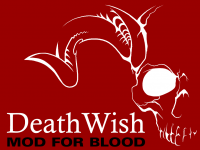
Death Wish is often held up as a standard bearer for custom content
Due to the high fan demand for more Blood content, especially after Monolith stopped working on the series in 1999, many add-on projects have sprung up. The goal of most of these has been to replicate or expand on the original Blood experience. This started on sites like Game Leader, and has since been kept going by repositories such as RTCM, blood.freeminded.de and The Bloody Repo, in addition to general purpose hosts such as ModDB and GameFront.
Interestingly, the amount of quality, completed Blood fan add-ons increased dramatically around and after the game's tenth anniversary, with efforts such as The Carnage Continues (2006), Rage Against the Machine (2007), Bloody Pulp Fiction (2009) and Death Wish (2011) reaching further than earlier attempted large scale projects such as The 13th Realm (1998), Blood Slaughter Files (1998), Crudox Cruo: Fresh BLOOD! (1998), and Tiny Town (1999) from the game's younger days.
A common joke used to be that Blood add-on projects were cursed to be incomplete, most notably with BloodLines (2002) which ultimately released unfinished though still fairly elaborate. Some early projects that did reach completion were the less ambitious Banzai's Add-On (1998), Time Episode (1999), and Killing Time (1999), as well as the classic three level add-on releases Eye of the Blood (1997), Journey to Hell (1998), Gods (1998), and Ravenloft (1998).
At least one endeavour, Dwayne Anderson's Legends of the Iconoclast, has managed to span both eras, with an initial release from 2001 to 2004 followed by a remake project started ten years later in April 2011 with releases in 2012 and 2017. Dustin "Bloatoid" Twilley's career has also stretched over many years, with early efforts such as Inherit the Earth (1999) and Hostile Takeover (2001) culminating a decade later with Death Wish in 2011, which then featured another six years of polish for version 1.4 in 2017 and further. This maturation is part of the reason why Death Wish is often held up as the gold standard for Blood add-ons.
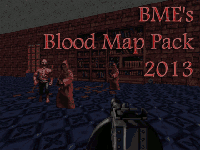
Between these two periods in the mid-2000s, a large chunk of the new releases came from the Russian Blood Community and related fan-base, such as The Outpost Mortem (2005), The Sect War (2005), Sectant (2006), and Old Friend (2007).
Subsequent major original releases have included French Meat and French Meat 2 (2012, 2019) as well as Caleb Will Have His Revenge on Toronto (2013-present), with new campaigns still in development. The comparative lull in new episodes in the later 2010s was broken with Out for Blood, The Way of Ira, Fleshed Out, Trauma Therapy and 500 Milliliters of /vr/ since the latter half of 2019.
Individual mappers such as Martin and Jason Brentnall, David Wikström, Austin Adams and Vili Nyström have also developed notable portfolios. Meanwhile, the Alone in the Dark series of mods has focused on expanding the technical scope of the game, establishing efforts such as a custom Voxel Pack and the Weapons Mod, among others. Curator BME put out a complete collection of Blood maps called BME's Blood Map Pack each year from 2013 to 2019, following from his re-scripted releases of many classic add-ons. More selective sets such as The Best of Blood.Freeminded.De (2011) and the Blood Chronicles (2004, 2014) volumes have also been compiled.
Since 2017, these fan campaigns can now be played outside the original DOS executable via BloodGDX, leading to an increased interest shown through Let's Play and video walkthrough series on YouTube (most notably by Pagb666). The later released NBlood source port (and fork included within Raze) can also load custom maps, with a new subsystem being utilized by No Hope in Sight and Eviction.
Fan content also largely retains compatibility with the official remaster of the game developed by Night Dive Studios called Blood: Fresh Supply, which also offers new modding potential due to its underlying Kex Engine, such as having a functional scripting system (currently being pushed by the Extra Crispy mod, as well as Arcade Mode). This excitement has lead to revived or updated versions to be worked on for Death Wish, Bloody Pulp Fiction and the once cursed Bloodlines, as well as overhaul mods such as the Blood Upscale Pack and the Blood Voxel Pack.
Development [edit]
Main article: Development of Blood
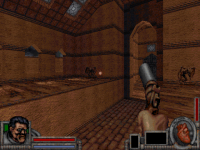
Development screamshot featuring Michael and an early HUD
QStudios, with the supervision of Apogee Software, started development of Blood under the title "Horror 3D" in early 1994. This was in parallel with several other projects on the Build engine, namely Duke Nukem 3D, Shadow Warrior 3D and Ruins: Return of the Gods. At this point in time the QStudios "office" was the family room of designer Nick Newhard's house. After the successful release of Duke Nukem 3D, development progress was made public starting in June 1996 with weekly updates on first the 3D Realms and then later the official Blood websites.
QStudios was merged into Monolith Productions and its offices in July 1996. Growing conflicts with 3D Realms over the development direction of the Build engine under Ken Silverman as well various personal and professional disagreements over staffing and contract issues led to the publisher being changed to GT Interactive starting in November 1996 with Rick Raymo as producer. 3D Realms instead focused on completing Shadow Warrior.
Sometime during the game's development there was a leak onto the Internet of the Blood source code by an employee at a computer repair shop, dated February 17, 1996, which was reacted to severely by the game's publisher. Eventually Monolith settled the case in court, but the released files became known to the community as the Blood Alpha. This beta demo contains several differences from the released game, including Caleb as a robed fanatic named Michael; his character was later greatly expanded by his actor Stephan Weyte. The shareware version also contained several differences, such as delirium mushrooms and a different theme.
The shareware version of Blood was released on March 7, 1997 following the game entering the beta stage on January 2nd. The game went gold on April 25th and was first released in North American retail stores on May 31, 1997 by GT Interactive, with the game coming to Europe on June 30, 1997 published by Eidos.
Modernization Efforts [edit]
See also: List of Source Ports and Recreations
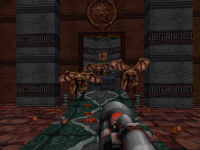
BloodCM is currently the most accurate Blood recreation
Despite the best efforts of fans, most notably the Blood Source Campaign, the source code to Blood has never been released. This has lead to projects like Transfusion, ZBlood, BloodCM, and others which attempt to recreate the game or game's style on more open and flexible alternative engines.
The Build engine code has been released, as has the code to the similar games Duke Nukem 3D and Shadow Warrior. Based on this, a few source port projects have been attempted, which vary from recreation projects by reading the original game's assets rather than merely adapting or recreating them; something much less ambiguous legally.
The first source port to have a stable public release was BloodGDX, partly created via referencing the leaked full Blood Alpha source code. Both BloodCM and BloodGDX were developed by Alexander "M210" Makarov, transitioning from one to the other. GDX was later joined by NBlood, a solution based on the EDuke32 engine by Alexey "Nuke.YKT" Khokholov. The fact that both of these were by Russian coders has lead them to sometimes be referred to as the "Slav Ports". NBlood was subsequently forked as part of the Raze project.
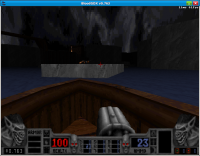
BloodGDX was the first stable released source port
A major inhibitor for such projects has been that Blood does not store its game logic externally by having any sort of scripting ability, the way Duke Nukem 3D does with CON files, making its functions fairly opaque and thus harder to reverse engineer. True modding of Blood game logic was thought impossible until recently with QAV file editing such as with the Weapons Mod. The game does not even support the ability to use external content (as Duke had with GRP files, Doom had with WADs, and Blood II featured with REZ files) besides maps or episode INI files, so all modifications that use new multimedia are done via overwriting, at least temporarily, existing base assets. According to Nick Newhard, this lack of flexibility was even a concern during the game's development.
In August 2012, Jason Hall pitched a modern upgraded version of Blood for current systems and consoles, but was unable to generate significant enough interest from Atari in order to move forward. Others also expressed an interest in such a project over the next few years, including Devolver Digital who published updated versions of Duke Nukem 3D and Shadow Warrior, Interceptor Entertainment who purchased 3D Realms, and Night Dive Studios, who specialize in reviving older games.
On December 7, 2018 it was announced that Atari had granted Night Dive Studios a license to produce a proclaimed "remastered version" of the original Blood refitted onto the Kex Engine. This was released on May 9, 2019 as Blood: Fresh Supply. In addition to working on contemporary systems and using modern frameworks, it also features advanced features such as an internal scripting system, online and split-screen multiplayer, new graphical effects, a customizable difficulty mode and a new mouse-aiming and controller interface. Divergences from the original, a troubled patching process, and still limited cross-platform compatibility have provoked controversy however.
Release and Critical Reception [edit]
"With the overwhelming success of the Duke Nukem 3D shareware release and anticipation already building for 3D Realms' upcoming Shadow Warrior, we have some understandably high expectations to live up to. At this point, we are confident that Blood will surpass those expectations by leaps and bounds, just as it has already surpassed our own."--Blood Website
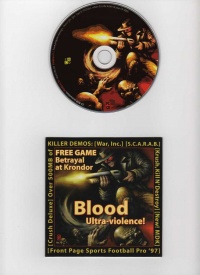
An example of a packaged version of the Blood shareware from the time of its original release
Blood received a metascore of 83 from MobyGames, holds and a score of 82 on Metacritic. Its highest rating (100) was given by The Adrenaline Vault (the first to receive a five star rating; later matched by Shogo), an opinion shared by 3D Action Gamers and PC Gaming, while its lowest (60) came from Computer Games Magazine. The game held a score of four and half stars on GOG.com prior to it being merged with Fresh Supply, featuring highly complimentary user reviews.
Blood soon grew into a cult classic, especially among fans of other Build engine titles. After its release Monolith Productions put a selection of contemporary reviews of the game up on the Blood website, most of which are now only available through the Wayback Machine.
Due to its graphic violence, Blood was placed on the BPjM list of restricted games in Germany. A period editorial for the Los Angeles Times derided both Blood and Redneck Rampage, stating that "just when you thought bloody shoot-'em-up games had gone too far in adolescent humor and senseless gore, these titles go even further." An article on Salon commented upon the infamous "bathtub of blood" advertisement for Blood in relation to the video game controversy following the Columbine shooting.
Company executive Jason Hall responded to contemporary criticism of the game on Usenet in this BBS post, most of which concerned its use of the then out-dated Build engine when compared to the likes of Quake and a perceived over similarity to its fellow Build engine stable-mate Duke Nukem 3D. This was also occasionally raised as a benefit, with Blood being argued as the pinnacle of the established 2.5D first-person shooter pantheon. Several reviewers also praised Blood for its unique setting and gothic elements, differentiating it from the dominate science fiction trappings seen in Doom and Duke Nukem 3D. Some drew comparisons instead to the dark fantasy of Heretic and Hexen, although still noting its furthering of the interactivity exhibited in 3D Realms games.

The infamous bathtub advertisement for Blood that appeared in magazines following the game's release in 1997
Both contemporary and modern reviews have noted the game's sometimes brutal difficulty, as did level designer James Wilson III himself, earning it both praise and criticism. Some have even observed that the game possesses an inverted difficulty curve, with the first episode being the hardest due to its lack of the more damaging weapons and stronger items. Later skill levels, most notably Extra Crispy, were said to have been balanced with cooperative play in mind.
Creative director Nick Newhard has expressed regret over how much content was available in the game's shareware release, believing that it satiated players at the expense of encouraging them to seek out and purchase the full retail version. He has also remarked that the Life Leech weapon and the high hit-scan accuracy of the Tommy Gun wielding Fanatics negatively affected the game's balance.
GamingOnLinux reviewer Hamish Paul Wilson decided in a 2015 retrospective that Blood was easily the best of the three major Build engine games, stating that Blood was "one of the most underrated shooters of the whole decade. Blood arguably built more on the legacy of Duke Nukem 3D than Shadow Warrior did, taking its gameplay to sophisticated new heights and offering its referential overtones with an even greater degree of refinement." In a 2017 video review of ZBlood prominent YouTuber Gmanlives agreed, commenting that out of the major Build engine games Blood always "edged itself out as [his] favourite of the three".
Player Attack described Blood in a 2011 article as "the best of the Build engine games after Duke Nukem 3D, with its combination of scary atmosphere, great level design and challenging gameplay putting it above the rest." Screen Rant concluded in a 2019 article that while "it was one of many Doom clones in the vein of Wolfenstein and Duke Nukem, and while not a lot of people played it, it is now regarded as one of the best FPS games of its time."
Blood is indexed in the Encyclopedia of Weird Westerns: Supernatural and Science Fiction Elements in Novels, Pulps, Comics, Films, Television and Games by Paul Green. The manwha Priest is said to be "inseparably related" to Blood in terms of inspiration, and was adapted into a motion picture; both notably feature battles with the undead similar to the fan favourite E1M3: Phantom Express level. The upcoming "boomer shooter" Cultic, being published by 3D Realms, exudes an obvious influence from Blood.
See Also [edit]
- Bugs in Blood: a list of known bugs in Blood.
- Blood Screamshot Gallery: a gallery of Blood screamshots.
- Cutscene Image Gallery: a gallery of cut scene shots, including those from Blood.
External Links [edit]
- Blood's Official Website
- Official Blood Atari Page
- Old GT Interactive Page
- Official Blood page from TEN
- Blood on Wikipedia
- Old Blood Development Website (Weekly Updates from June 1996 - December 1996)
- Blood Development Weekly Updates from August 1996 - May 1997
- Blood at FirstPersonShooters.net
- Blood series on TV Tropes
- Blood at the Videogame Music Preservation Foundation Wiki
- Blood DOSBox Screenshots
- Blood Let's Play Archive
Articles [edit]
- GT Interactive and Monolith's 'Blood' shareware spilling all over the Internet, Business Wire, April 8, 1997 (partial archive).
- PC Zone preview scans
- Game Center's preview of Blood
- Gamesmania Sneak Peaks - Blood
- Blood preview - CD Mag
- Blood preview from Game Slice (February 1997)
- Blood vs. Shadow Warrior: The True Battle Begins! - The Adrenaline Vault
- Game Center - Shareware Gold: Blood (April 14, 1997)
- "What was your favourite chapter from the original Blood, and why?" - Planet Blood Mailbag (March 7, 2000)
- Retro Review Grudge Match: Duke Nukem 3D vs Blood - NAG (September 14, 2010)
- The Forgotten First-Person Shooters You Need to Play - 1UP.com (October 2010)
- 10 great PC games that need a comeback - Big Download (January 13, 2009)
- The Big Three Build Engine Games on GOG - GamingOnLinux (June 23, 2015)
- Underdogs: six forgotten classics from PC gaming history - Geek Squad (July 14, 2015)
- The Top 25 Horror Games Of All Time - Game Informer (October 31, 2015) (Mirror)
- Going in with a bang – the best debuts in the history of gaming - GAMEPRESSURE.COM (November 25, 2015)
- The 25 Best Horror Games on PC (Blood at 25) - Rock, Paper, Shotgun (May 12, 2017)
- 10 Horror Games That are Perfect to Play on Halloween! - Bloody Disgusting (October 31, 2018)
- How do two companies own the rights to Blood? - Polgyon (December 12, 2018)
Reviews [edit]
Contemporary (1997-2000)
- Shareware review from The Adrenaline Vault (1997)
- Review from The Adrenaline Vault (April 24, 1997)
- Shareware review by Games Domain (March 1997)
- Review by GamePro (May 31, 1997)
- Review by Games Domain (June 1997)
- Review by PCM&E (June 2, 1997)
- Review by 3D Gamers (June 12, 1997)
- Review from GameSpot (June 26, 1997)
- Shareware review by PC Gaming (1997)
- Review by PC Gaming (1997)
- Review by Sharepaper (1997)
- Review by Game Demo (1997)
- Review from Game Power (1997)
- Review from Games Mania (1997)
- Game of the Month - Blood Review
- Review by Game Pen (1997)
- Review by Planet Quake (1997)
- Review scans - PC Gamer
- Review scans - PC PowerPlay (Australia)
- Review by Gamezilla (October 13, 1999)
- Review by Hot Games
Retrospective (2000-present)
- Blood Review - Just Games Retro (July 22, 2006)
- The 28 Best Ever First Person Shooter Games - PC Adviser (Blood at 27; October 18, 2008)
- Review from Retro Gamer (October 27, 2008)
- Review from A Force for Good (July 14, 2010)
- Review from Thunderbolt (September 25, 2010)
- GOG Box: Blood - GameFront (March 23, 2012)
- You Should Have Played This: Blood - The Married Gamers (February 19, 2013)
- Saturday Crapshoot: Blood - PC Gamer (May 31, 2013)
- Review from Examiner.com (June 24, 2013)
- Have you Played that Game: Blood - G3AR (August 22, 2013)
- Review: Blood (One Unit Whole Blood Edition) - Retro Sensei (October 30, 2013)
- Review: Blood (One Unit Whole Blood Edition) - Old Game Hermit (October 30, 2013)
- Super Adventure in Gaming - Blood (October 31, 2013)
- Lookback on Blood - Eden for Gaming (March 6, 2014)
- Heti retro bemutató: Blood (July 26, 2014) (Hungarian)
- Review from MyStudentStyle (August 20, 2014)
- Review from The Honest Gamers (October 28, 2014)
- Throwback Thursday: Blood - AusGamers (February 26, 2015)
- The Classic PC Games You Must Play - Blood - Kotaku (March 1, 2015)
- Classic Games Resurrected: Blood - HubPages (April 20, 2015)
- Blood Review - Game Nostalgia (May 29, 2015)
- Review from Hey Poor Player (2015)
- 4-One Retro Corner: Blood (January 3, 2016)
- Hardcore Gaming 101: Blood (March 13, 2016)
- Bullet Points podcast - Episode 22: Blood (August 15, 2016)
- Video Game Review: Blood - MovieFanCentral (November 2016)
- Blood: Blast from the Past Review - Previous Weapon (July 29, 2017)
- Hardcore Gaming 101 (October 16, 2017)
- Have You Played… Blood? - Rock, Paper, Shotgun (October 31, 2017)
- Review: Blood - A MOST AGREEABLE PASTTIME (June 4, 2017)
- Classic Video Games Review (1997) Blood : Occult and Horror Video Game - Stulman (2018)
- Review from Home of the Underdogs
- Review from The Blood Theatre
- Review from Retro Garden
- Review from UAC Labs (Spanish)
Blogs
- Old school review: Blood (February 6, 2008) (Translated)
- A First Person Shooter Worth Playing by Mattias Gustavsson (August 30, 2008)
- River City Retro: Blood... just blood (May 1, 2010)
- Review from POWET.TV (June 4, 2010)
- Review from VGJUNK (October 20, 2010)
- Review from The Dukes Playground (February 7, 2012)
- Review from PolyPwn (August 14, 2012)
- Review from Old PC Gaming (May 11, 2013)
- Review from 8-bit Wizard (October 30, 2013)
- Blood | I want Jojo, I Want JoJo, I WANT JOJO! (May 21, 2014)
- Review from Videogame Potpourri (February 12, 2014)
- Review from Muzzleland Press (December 11, 2014)
- Cult Review: Blood - The Video Game Library (February 19, 2015)
- Review from PekoeBlaze (May 3, 2015)
- Blood: 20th Birthday & Retrospective - Heavy Metal Otaku (May 31, 2017)
- Blood, The Perfect Game For This October - Autism-o-meter (October 1, 2020)
Source: https://blood-wiki.org/index.php/Blood
0 Response to "Creepy Beef and Webm Fill Your Soft Belly With Beef"
Post a Comment